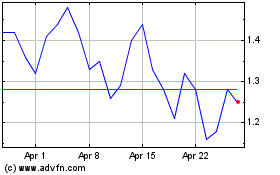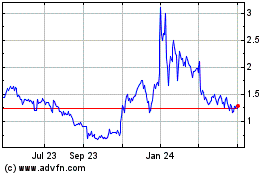Data Showcases Potential Benefits in Gait
Function and Balance in Broad Range of Severity and Level of Spinal
Cord Injury, as well as Time since Injury
Ekso Bionics Holdings, Inc. (NASDAQ:EKSO), an industry leader
in exoskeleton technology for medical and industrial use, today
announced the publication of data from a multicenter Pan-Euro study
that assessed the company’s wearable exoskeleton, EksoGT™, in a
diverse and representative spinal cord injury (SCI) population.
Published in the International Spinal Cord Society’s (ISCOS)
peer-reviewed journal, Spinal Cord, the results showed that the
EksoGT™ is safe and feasible for use, as well as improves training
characteristics and changes in gait function for persons with SCI,
including those with paraplegia and tetraplegia, recent and chronic
injuries, as well as complete or incomplete SCI.
Photos accompanying this announcement are
available
athttp://www.globenewswire.com/NewsRoom/AttachmentNg/23687e16-d786-4ff6-9bbb-79da499ada87http://www.globenewswire.com/NewsRoom/AttachmentNg/3ff474ba-70fe-4224-87ab-e7178fe07f75
“The Pan-Euro study is one of the first to
evaluate wearable exoskeletons in a heterogeneous SCI population,
providing additional insights across a wider range of patients.
Previous exoskeleton studies focused on complete SCI,” commented
Thomas Looby, president and chief executive officer of Ekso
Bionics. “In combination with the 35 U.S. studies and 25 EMEA
studies conducted with the EksoGT™, we are paving the way on
quantifying the benefits of exoskeleton gait rehabilitation and
ultimately redefining rehabilitation for a broader range of
patients with SCI.”
There are now 13 publications with clinical
evidence to support the use of EksoGT, for a total of 159
participants with various conditions including incomplete and
complete SCI, and stroke, excluding case studies and reviews. There
are 78 exoskeleton publications across the exoskeleton industry
with a total of 765 participants.
Results demonstrated that all training
characteristics increased significantly from baseline to the end of
the training period (up time: F = 2.168, P < 0.001; walk time: F
= 10.988, P < 0.001; steps: F = 15.556, P < 0.001) for all
SCI subgroups: recently (<1 year) and chronically (>1 year)
injured, paraplegia and tetraplegia, and incomplete and complete
injury (P < 0.001). Participants with incomplete injuries had
more steps per session than those with complete SCI, with a mean
difference of 335 steps (95% CI 112-558, P = 0.004).
In the recently injured group, gait function
increased from five participants (20%) at baseline to 14
participants (56%) by the end of the training period (test
statistic = 7.11, P = 0.004). This group also showed significant
improvement in the 10 Meter Walk Test (10MWT), Timed Up and Go
(TUG), Berg Balance Scale (BBS) and Lower Extremity Motor Score
(LEMS) results (P < 0.05). Gait function for the chronic injury
group increased from 11 participants (40%) to 12 participants
(44%), including one participant with a 13 year-old T12 injury, AIS
D, acquiring gait function by the end of the training period. The
group observed improvements in TUG and BBS results (P < 0.05).
Both groups retained improved gait function at follow-up. In
addition, two participants with chronic, complete SCI reported
improved sitting balance following training.
“The Pan-Euro study shows that the EksoGT™ is
safe and feasible for persons with SCI with different levels and
severity of injuries and that it may have potential benefits in
those with incomplete SCI on gait and balance function,” commented
Carsten Bach Baunsgaard, M.D., at the Clinic for Spinal Cord
Injuries, Rigshospitalet, University of Copenhagen, and first
author of the published paper. “Furthermore, the study also shows
that it can be used by recently injured persons as well as those
who have sustained their injuries several years ago. We look
forward to bringing more of our patients onto their feet
earlier.”
The open-label, prospective study with a pre-
and post-design was conducted at nine European SCI rehabilitation
centers. The multicenter study was designed to assess safety,
feasibility, training characteristics and changes in gait function
for SCI using the EksoGT™ exoskeleton. The study enrolled a total
of 60 participants, 52 of whom completed at least 16 of the 24
exoskeleton gait training sessions that were conducted as an “add
on” to their existing training three times per week over a total of
eight weeks. The primary objective of the study was to assess
safety and feasibility of exoskeleton training, while the secondary
objective evaluated changes in gait function outside of the
exoskeleton. Assessments were conducted at baseline, the twelfth
training session, the final training session, and at a follow up
session four weeks after the last training session.
The Spinal Cord publication, titled “Gait
training after spinal cord injury: safety feasibility and gait
function following 8 weeks of training with the exoskeletons from
Ekso Bionics” is available online at the following link:
https://www.nature.com/articles/s41393-017-0013-7.
For more information about Ekso Bionics or the EksoGT™, visit
www.eksobionics.com.
About EksoGT™EksoGT™ is the
first exoskeleton cleared by the FDA for use with stroke and spinal
cord injuries from L5 to C7. The EksoGT with SmartAssist™ software
is the only exoskeleton available for rehabilitation institutions
that can provide adaptive amounts of power to either side of a
patient’s body, challenging the patient as they progress through
their continuum of care. The suit’s patented technology provides
the ability to mobilize patients earlier, more frequently, and with
a greater number of high intensity steps. To date, this device has
helped patients take more than 80 million steps in over 185
rehabilitation institutions around the world.
About Ekso Bionics® Ekso
Bionics® is a leading developer of exoskeleton solutions that
amplify human potential by supporting or enhancing strength,
endurance and mobility across medical, industrial and defense
applications. Founded in 2005, the company continues to build upon
its unparalleled expertise to design some of the most cutting-edge,
innovative wearable robots available on the market. Ekso Bionics is
the only exoskeleton company to offer technologies that range from
helping those with paralysis to stand up and walk, to enhancing
human capabilities on job sites across the globe, to providing
research for the advancement of R&D projects intended to
benefit U.S. defense capabilities. The company is headquartered in
the Bay Area and is listed on the Nasdaq Capital Market under the
symbol EKSO. For more information,
visit: www.eksobionics.com.
Forward-Looking StatementsAny
statements contained in this press release that do not describe
historical facts may constitute forward-looking statements.
Forward-looking statements may include, without limitation,
statements regarding (i) the plans and objectives of management for
future operations, including plans or objectives relating to the
design, development and commercialization of human exoskeletons,
(ii) estimates or projection of financial results, financial
condition, capital expenditures, capital structure or other
financial items, (iii) the Company's future financial performance
and (iv) the assumptions underlying or relating to any statement
described in points (i), (ii) or (iii) above. Such forward-looking
statements are not meant to predict or guarantee actual results,
performance, events or circumstances and may not be realized
because they are based upon the Company's current projections,
plans, objectives, beliefs, expectations, estimates and assumptions
and are subject to a number of risks and uncertainties and other
influences, many of which the Company has no control over. Actual
results and the timing of certain events and circumstances may
differ materially from those described by the forward-looking
statements as a result of these risks and uncertainties. Factors
that may influence or contribute to the inaccuracy of the
forward-looking statements or cause actual results to differ
materially from expected or desired results may include, without
limitation, the Company's inability to obtain adequate financing to
fund the Company's operations and necessary to develop or enhance
our technology, the significant length of time and resources
associated with the development of the Company's products, the
Company's failure to achieve broad market acceptance of the
Company's products, the failure of our sales and marketing
organization or partners to market our products effectively,
adverse results in future clinical studies of the Company's medical
device products, the failure to obtain or maintain patent
protection for the Company's technology, failure to obtain or
maintain regulatory approval to market the Company's medical
devices, lack of product diversification, existing or increased
competition, and the Company's failure to implement the Company's
business plans or strategies. These and other factors are
identified and described in more detail in the Company's filings
with the SEC. To learn more about Ekso Bionics please visit us at
www.eksobionics.com. The Company does not undertake to update these
forward-looking statements.
Media Contact:Carrie
Yamond917-371-2320cyamond@lazarpartners.com
Investor Contact:Matthew
Ventimiglia212-599-1265investors@eksobionics.com
Ekso Bionics (NASDAQ:EKSO)
Historical Stock Chart
From Mar 2024 to Apr 2024

Ekso Bionics (NASDAQ:EKSO)
Historical Stock Chart
From Apr 2023 to Apr 2024
